Applied Pathophysiology and Pharmacology: ICU Patient Report
VerifiedAdded on 2023/01/03
|12
|4464
|67
Report
AI Summary
This report presents a case study of a 67-year-old patient, Mr. ABC, admitted to the ICU with cardiac arrest and diagnosed with atrial fibrillation (AF), type 2 diabetes, and chronic kidney disease. The report details the patient's anatomy, physiology, and pathophysiology, focusing on the underlying causes of AF and related symptoms, including the use of haemotological results and investigations. It examines the pharmacology of the medications used to treat the patient, including Amiodarone, Bisoprolol, and Enoxaparin, detailing their mechanisms of action, dosages, and potential side effects. Furthermore, the report addresses nursing care considerations for the patient. The report concludes with key points, and recommendations for future practices, providing a comprehensive overview of the patient's condition, treatment, and management within an ICU setting.

APPLIED
PATHOPHYSIOLOGY AND
PHARMACOLOGY
PATHOPHYSIOLOGY AND
PHARMACOLOGY
Paraphrase This Document
Need a fresh take? Get an instant paraphrase of this document with our AI Paraphraser

TABLE OF CONTENTS
INTRODUCTION...........................................................................................................................1
MAIN BODY..................................................................................................................................2
Anatomy, Physiology and pathophysiology.............................................................................2
Identify the normal anatomy and physiology of body system for patient and presented
problems with..............................................................................................................................2
Underlying the pathophysiology of patient condition and relate with signs, symptoms and
haemotolical results.....................................................................................................................3
Investigations in the Pathophysiology on definition of condition...............................................4
Why patient has this problem......................................................................................................4
Pharmacology..............................................................................................................................4
Nursing Care................................................................................................................................7
CONCLUSION................................................................................................................................8
Summarise key points..................................................................................................................8
Recommendations for future practices........................................................................................9
REFERENCES..............................................................................................................................10
INTRODUCTION...........................................................................................................................1
MAIN BODY..................................................................................................................................2
Anatomy, Physiology and pathophysiology.............................................................................2
Identify the normal anatomy and physiology of body system for patient and presented
problems with..............................................................................................................................2
Underlying the pathophysiology of patient condition and relate with signs, symptoms and
haemotolical results.....................................................................................................................3
Investigations in the Pathophysiology on definition of condition...............................................4
Why patient has this problem......................................................................................................4
Pharmacology..............................................................................................................................4
Nursing Care................................................................................................................................7
CONCLUSION................................................................................................................................8
Summarise key points..................................................................................................................8
Recommendations for future practices........................................................................................9
REFERENCES..............................................................................................................................10

INTRODUCTION
Pharmacology is based on the branch of medicine and pharmaceutical sciences which are
concerned with study of drugs, medication action where a drug will be broadly or narrowly
defined as any natural, man-made. On the other hand, Pathophysiology is defined as functional
perspectives which comprehensive guide for health care practitioners, identifying the different
core factors responsible for health disease.
Brief description of the patient and presenting history
In this report, it is basically explaining the patient, who are admitted and treated in ICU
department. Mr. ABC is patient. This case study will discuss the A-E assessment of Mrs ABC,
physiology and pathophysiology of atrial fibrillation (AF). Generally, it is focused on the
medication, patient received to treat the AF as such Amiodarone, bisoprolol and anticoagulation.
Mrs ABC is a 67 years old lady and admitted in the hospital for intensive healthcare due to
cardiac arrest, metabolic acidosis (Ashelford, Raynsford and Taylor, 2019). Initially, she was
suffering from unusual health condition such as vomiting, septic shower, and diarrhea.
According to the given case study, it has been identified the medical history of patient, type
2 diabetes Mellitus and chronic kidney disease (CKD). At the time of admission, patient was
successfully intubated at the time of cardiac arrest, its invasive line related venous catheter and
arterial was completely inserted. In past years, Mrs. ABC has been increasingly haemoglobin in
which indicate as condition of anemia. These can reduce the low blood cell mass approximately
12.0g/dL.
Rationale for patient choice
The rationale of this study is to identify the major causes among old age people. That’s why,
it has been chosen as Mrs. ABC old women, who have already face certain kind of poor health
condition or situation. Therefore, this study has represented the significant of investigation
related the chosen patient, it does not matter whether patient become women, men.
1
Pharmacology is based on the branch of medicine and pharmaceutical sciences which are
concerned with study of drugs, medication action where a drug will be broadly or narrowly
defined as any natural, man-made. On the other hand, Pathophysiology is defined as functional
perspectives which comprehensive guide for health care practitioners, identifying the different
core factors responsible for health disease.
Brief description of the patient and presenting history
In this report, it is basically explaining the patient, who are admitted and treated in ICU
department. Mr. ABC is patient. This case study will discuss the A-E assessment of Mrs ABC,
physiology and pathophysiology of atrial fibrillation (AF). Generally, it is focused on the
medication, patient received to treat the AF as such Amiodarone, bisoprolol and anticoagulation.
Mrs ABC is a 67 years old lady and admitted in the hospital for intensive healthcare due to
cardiac arrest, metabolic acidosis (Ashelford, Raynsford and Taylor, 2019). Initially, she was
suffering from unusual health condition such as vomiting, septic shower, and diarrhea.
According to the given case study, it has been identified the medical history of patient, type
2 diabetes Mellitus and chronic kidney disease (CKD). At the time of admission, patient was
successfully intubated at the time of cardiac arrest, its invasive line related venous catheter and
arterial was completely inserted. In past years, Mrs. ABC has been increasingly haemoglobin in
which indicate as condition of anemia. These can reduce the low blood cell mass approximately
12.0g/dL.
Rationale for patient choice
The rationale of this study is to identify the major causes among old age people. That’s why,
it has been chosen as Mrs. ABC old women, who have already face certain kind of poor health
condition or situation. Therefore, this study has represented the significant of investigation
related the chosen patient, it does not matter whether patient become women, men.
1
⊘ This is a preview!⊘
Do you want full access?
Subscribe today to unlock all pages.

Trusted by 1+ million students worldwide
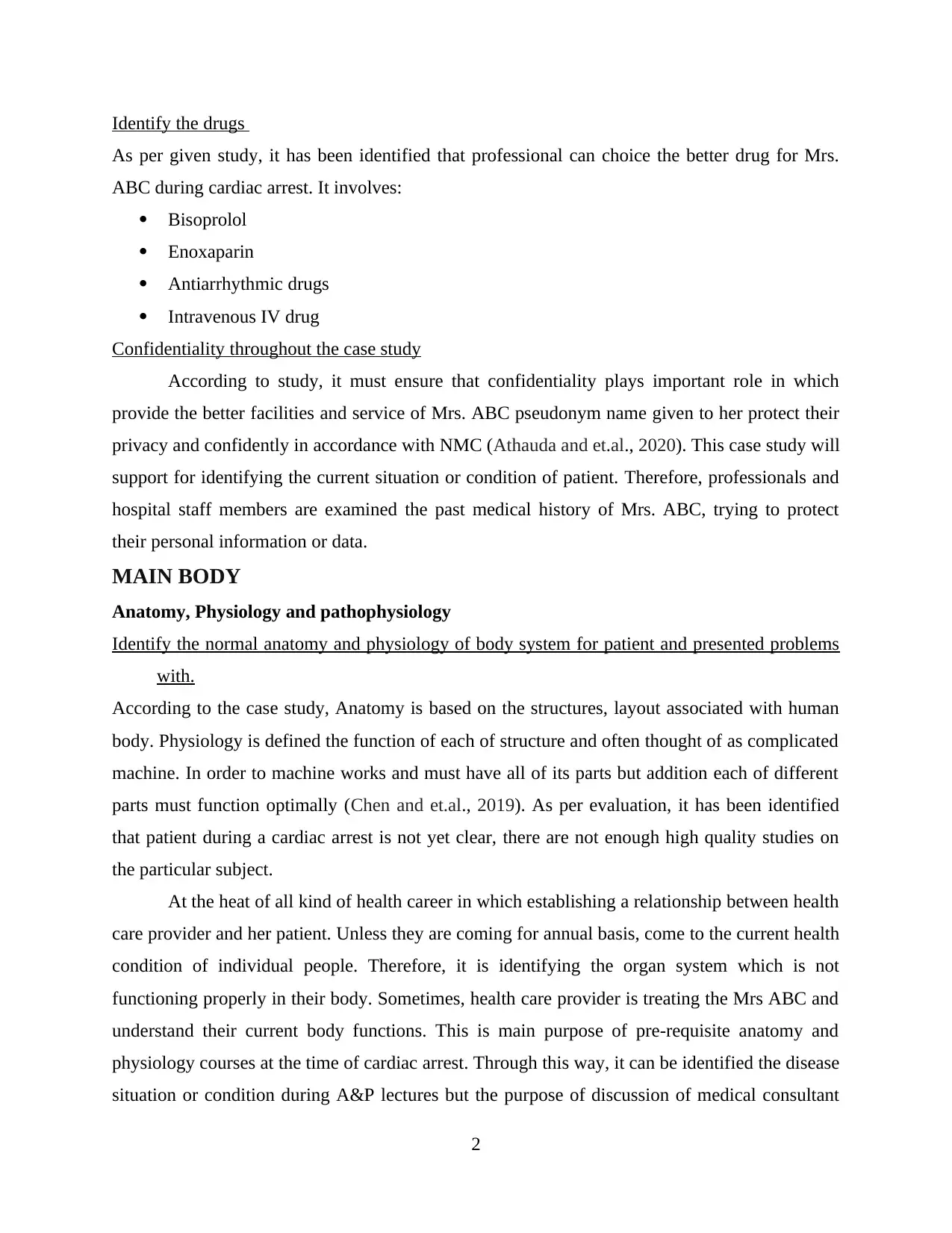
Identify the drugs
As per given study, it has been identified that professional can choice the better drug for Mrs.
ABC during cardiac arrest. It involves:
Bisoprolol
Enoxaparin
Antiarrhythmic drugs
Intravenous IV drug
Confidentiality throughout the case study
According to study, it must ensure that confidentiality plays important role in which
provide the better facilities and service of Mrs. ABC pseudonym name given to her protect their
privacy and confidently in accordance with NMC (Athauda and et.al., 2020). This case study will
support for identifying the current situation or condition of patient. Therefore, professionals and
hospital staff members are examined the past medical history of Mrs. ABC, trying to protect
their personal information or data.
MAIN BODY
Anatomy, Physiology and pathophysiology
Identify the normal anatomy and physiology of body system for patient and presented problems
with.
According to the case study, Anatomy is based on the structures, layout associated with human
body. Physiology is defined the function of each of structure and often thought of as complicated
machine. In order to machine works and must have all of its parts but addition each of different
parts must function optimally (Chen and et.al., 2019). As per evaluation, it has been identified
that patient during a cardiac arrest is not yet clear, there are not enough high quality studies on
the particular subject.
At the heat of all kind of health career in which establishing a relationship between health
care provider and her patient. Unless they are coming for annual basis, come to the current health
condition of individual people. Therefore, it is identifying the organ system which is not
functioning properly in their body. Sometimes, health care provider is treating the Mrs ABC and
understand their current body functions. This is main purpose of pre-requisite anatomy and
physiology courses at the time of cardiac arrest. Through this way, it can be identified the disease
situation or condition during A&P lectures but the purpose of discussion of medical consultant
2
As per given study, it has been identified that professional can choice the better drug for Mrs.
ABC during cardiac arrest. It involves:
Bisoprolol
Enoxaparin
Antiarrhythmic drugs
Intravenous IV drug
Confidentiality throughout the case study
According to study, it must ensure that confidentiality plays important role in which
provide the better facilities and service of Mrs. ABC pseudonym name given to her protect their
privacy and confidently in accordance with NMC (Athauda and et.al., 2020). This case study will
support for identifying the current situation or condition of patient. Therefore, professionals and
hospital staff members are examined the past medical history of Mrs. ABC, trying to protect
their personal information or data.
MAIN BODY
Anatomy, Physiology and pathophysiology
Identify the normal anatomy and physiology of body system for patient and presented problems
with.
According to the case study, Anatomy is based on the structures, layout associated with human
body. Physiology is defined the function of each of structure and often thought of as complicated
machine. In order to machine works and must have all of its parts but addition each of different
parts must function optimally (Chen and et.al., 2019). As per evaluation, it has been identified
that patient during a cardiac arrest is not yet clear, there are not enough high quality studies on
the particular subject.
At the heat of all kind of health career in which establishing a relationship between health
care provider and her patient. Unless they are coming for annual basis, come to the current health
condition of individual people. Therefore, it is identifying the organ system which is not
functioning properly in their body. Sometimes, health care provider is treating the Mrs ABC and
understand their current body functions. This is main purpose of pre-requisite anatomy and
physiology courses at the time of cardiac arrest. Through this way, it can be identified the disease
situation or condition during A&P lectures but the purpose of discussion of medical consultant
2
Paraphrase This Document
Need a fresh take? Get an instant paraphrase of this document with our AI Paraphraser
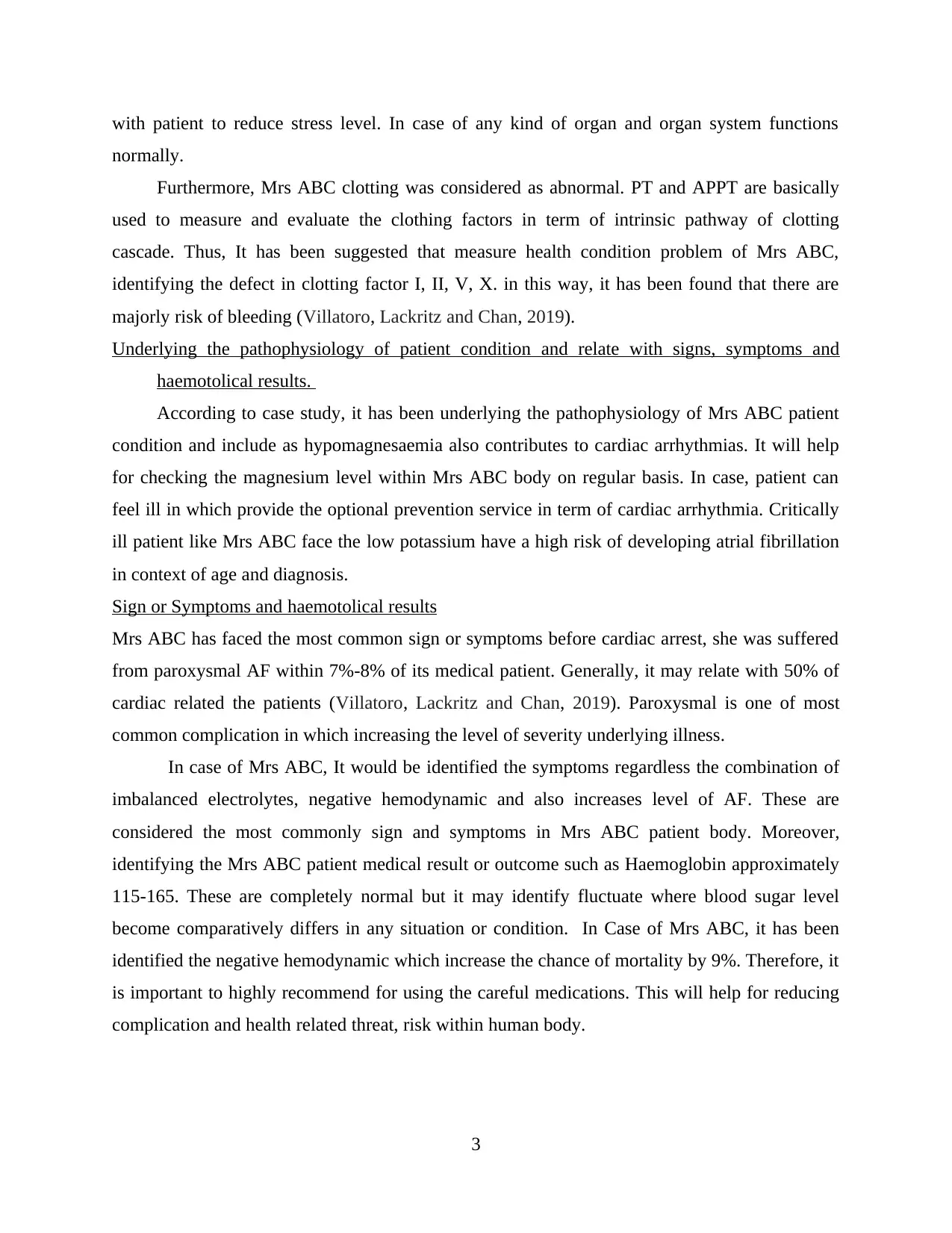
with patient to reduce stress level. In case of any kind of organ and organ system functions
normally.
Furthermore, Mrs ABC clotting was considered as abnormal. PT and APPT are basically
used to measure and evaluate the clothing factors in term of intrinsic pathway of clotting
cascade. Thus, It has been suggested that measure health condition problem of Mrs ABC,
identifying the defect in clotting factor I, II, V, X. in this way, it has been found that there are
majorly risk of bleeding (Villatoro, Lackritz and Chan, 2019).
Underlying the pathophysiology of patient condition and relate with signs, symptoms and
haemotolical results.
According to case study, it has been underlying the pathophysiology of Mrs ABC patient
condition and include as hypomagnesaemia also contributes to cardiac arrhythmias. It will help
for checking the magnesium level within Mrs ABC body on regular basis. In case, patient can
feel ill in which provide the optional prevention service in term of cardiac arrhythmia. Critically
ill patient like Mrs ABC face the low potassium have a high risk of developing atrial fibrillation
in context of age and diagnosis.
Sign or Symptoms and haemotolical results
Mrs ABC has faced the most common sign or symptoms before cardiac arrest, she was suffered
from paroxysmal AF within 7%-8% of its medical patient. Generally, it may relate with 50% of
cardiac related the patients (Villatoro, Lackritz and Chan, 2019). Paroxysmal is one of most
common complication in which increasing the level of severity underlying illness.
In case of Mrs ABC, It would be identified the symptoms regardless the combination of
imbalanced electrolytes, negative hemodynamic and also increases level of AF. These are
considered the most commonly sign and symptoms in Mrs ABC patient body. Moreover,
identifying the Mrs ABC patient medical result or outcome such as Haemoglobin approximately
115-165. These are completely normal but it may identify fluctuate where blood sugar level
become comparatively differs in any situation or condition. In Case of Mrs ABC, it has been
identified the negative hemodynamic which increase the chance of mortality by 9%. Therefore, it
is important to highly recommend for using the careful medications. This will help for reducing
complication and health related threat, risk within human body.
3
normally.
Furthermore, Mrs ABC clotting was considered as abnormal. PT and APPT are basically
used to measure and evaluate the clothing factors in term of intrinsic pathway of clotting
cascade. Thus, It has been suggested that measure health condition problem of Mrs ABC,
identifying the defect in clotting factor I, II, V, X. in this way, it has been found that there are
majorly risk of bleeding (Villatoro, Lackritz and Chan, 2019).
Underlying the pathophysiology of patient condition and relate with signs, symptoms and
haemotolical results.
According to case study, it has been underlying the pathophysiology of Mrs ABC patient
condition and include as hypomagnesaemia also contributes to cardiac arrhythmias. It will help
for checking the magnesium level within Mrs ABC body on regular basis. In case, patient can
feel ill in which provide the optional prevention service in term of cardiac arrhythmia. Critically
ill patient like Mrs ABC face the low potassium have a high risk of developing atrial fibrillation
in context of age and diagnosis.
Sign or Symptoms and haemotolical results
Mrs ABC has faced the most common sign or symptoms before cardiac arrest, she was suffered
from paroxysmal AF within 7%-8% of its medical patient. Generally, it may relate with 50% of
cardiac related the patients (Villatoro, Lackritz and Chan, 2019). Paroxysmal is one of most
common complication in which increasing the level of severity underlying illness.
In case of Mrs ABC, It would be identified the symptoms regardless the combination of
imbalanced electrolytes, negative hemodynamic and also increases level of AF. These are
considered the most commonly sign and symptoms in Mrs ABC patient body. Moreover,
identifying the Mrs ABC patient medical result or outcome such as Haemoglobin approximately
115-165. These are completely normal but it may identify fluctuate where blood sugar level
become comparatively differs in any situation or condition. In Case of Mrs ABC, it has been
identified the negative hemodynamic which increase the chance of mortality by 9%. Therefore, it
is important to highly recommend for using the careful medications. This will help for reducing
complication and health related threat, risk within human body.
3
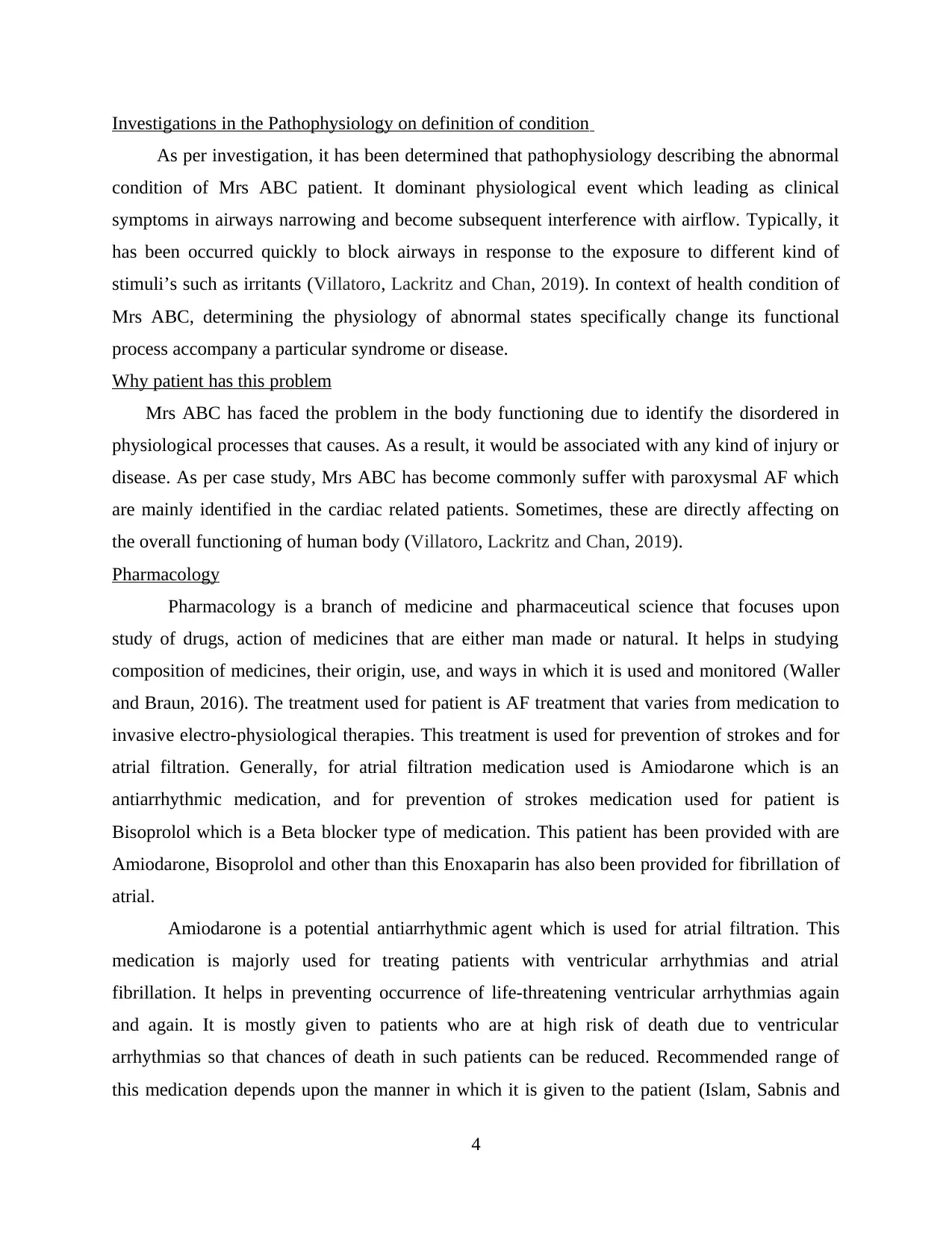
Investigations in the Pathophysiology on definition of condition
As per investigation, it has been determined that pathophysiology describing the abnormal
condition of Mrs ABC patient. It dominant physiological event which leading as clinical
symptoms in airways narrowing and become subsequent interference with airflow. Typically, it
has been occurred quickly to block airways in response to the exposure to different kind of
stimuli’s such as irritants (Villatoro, Lackritz and Chan, 2019). In context of health condition of
Mrs ABC, determining the physiology of abnormal states specifically change its functional
process accompany a particular syndrome or disease.
Why patient has this problem
Mrs ABC has faced the problem in the body functioning due to identify the disordered in
physiological processes that causes. As a result, it would be associated with any kind of injury or
disease. As per case study, Mrs ABC has become commonly suffer with paroxysmal AF which
are mainly identified in the cardiac related patients. Sometimes, these are directly affecting on
the overall functioning of human body (Villatoro, Lackritz and Chan, 2019).
Pharmacology
Pharmacology is a branch of medicine and pharmaceutical science that focuses upon
study of drugs, action of medicines that are either man made or natural. It helps in studying
composition of medicines, their origin, use, and ways in which it is used and monitored (Waller
and Braun, 2016). The treatment used for patient is AF treatment that varies from medication to
invasive electro-physiological therapies. This treatment is used for prevention of strokes and for
atrial filtration. Generally, for atrial filtration medication used is Amiodarone which is an
antiarrhythmic medication, and for prevention of strokes medication used for patient is
Bisoprolol which is a Beta blocker type of medication. This patient has been provided with are
Amiodarone, Bisoprolol and other than this Enoxaparin has also been provided for fibrillation of
atrial.
Amiodarone is a potential antiarrhythmic agent which is used for atrial filtration. This
medication is majorly used for treating patients with ventricular arrhythmias and atrial
fibrillation. It helps in preventing occurrence of life-threatening ventricular arrhythmias again
and again. It is mostly given to patients who are at high risk of death due to ventricular
arrhythmias so that chances of death in such patients can be reduced. Recommended range of
this medication depends upon the manner in which it is given to the patient (Islam, Sabnis and
4
As per investigation, it has been determined that pathophysiology describing the abnormal
condition of Mrs ABC patient. It dominant physiological event which leading as clinical
symptoms in airways narrowing and become subsequent interference with airflow. Typically, it
has been occurred quickly to block airways in response to the exposure to different kind of
stimuli’s such as irritants (Villatoro, Lackritz and Chan, 2019). In context of health condition of
Mrs ABC, determining the physiology of abnormal states specifically change its functional
process accompany a particular syndrome or disease.
Why patient has this problem
Mrs ABC has faced the problem in the body functioning due to identify the disordered in
physiological processes that causes. As a result, it would be associated with any kind of injury or
disease. As per case study, Mrs ABC has become commonly suffer with paroxysmal AF which
are mainly identified in the cardiac related patients. Sometimes, these are directly affecting on
the overall functioning of human body (Villatoro, Lackritz and Chan, 2019).
Pharmacology
Pharmacology is a branch of medicine and pharmaceutical science that focuses upon
study of drugs, action of medicines that are either man made or natural. It helps in studying
composition of medicines, their origin, use, and ways in which it is used and monitored (Waller
and Braun, 2016). The treatment used for patient is AF treatment that varies from medication to
invasive electro-physiological therapies. This treatment is used for prevention of strokes and for
atrial filtration. Generally, for atrial filtration medication used is Amiodarone which is an
antiarrhythmic medication, and for prevention of strokes medication used for patient is
Bisoprolol which is a Beta blocker type of medication. This patient has been provided with are
Amiodarone, Bisoprolol and other than this Enoxaparin has also been provided for fibrillation of
atrial.
Amiodarone is a potential antiarrhythmic agent which is used for atrial filtration. This
medication is majorly used for treating patients with ventricular arrhythmias and atrial
fibrillation. It helps in preventing occurrence of life-threatening ventricular arrhythmias again
and again. It is mostly given to patients who are at high risk of death due to ventricular
arrhythmias so that chances of death in such patients can be reduced. Recommended range of
this medication depends upon the manner in which it is given to the patient (Islam, Sabnis and
4
⊘ This is a preview!⊘
Do you want full access?
Subscribe today to unlock all pages.

Trusted by 1+ million students worldwide
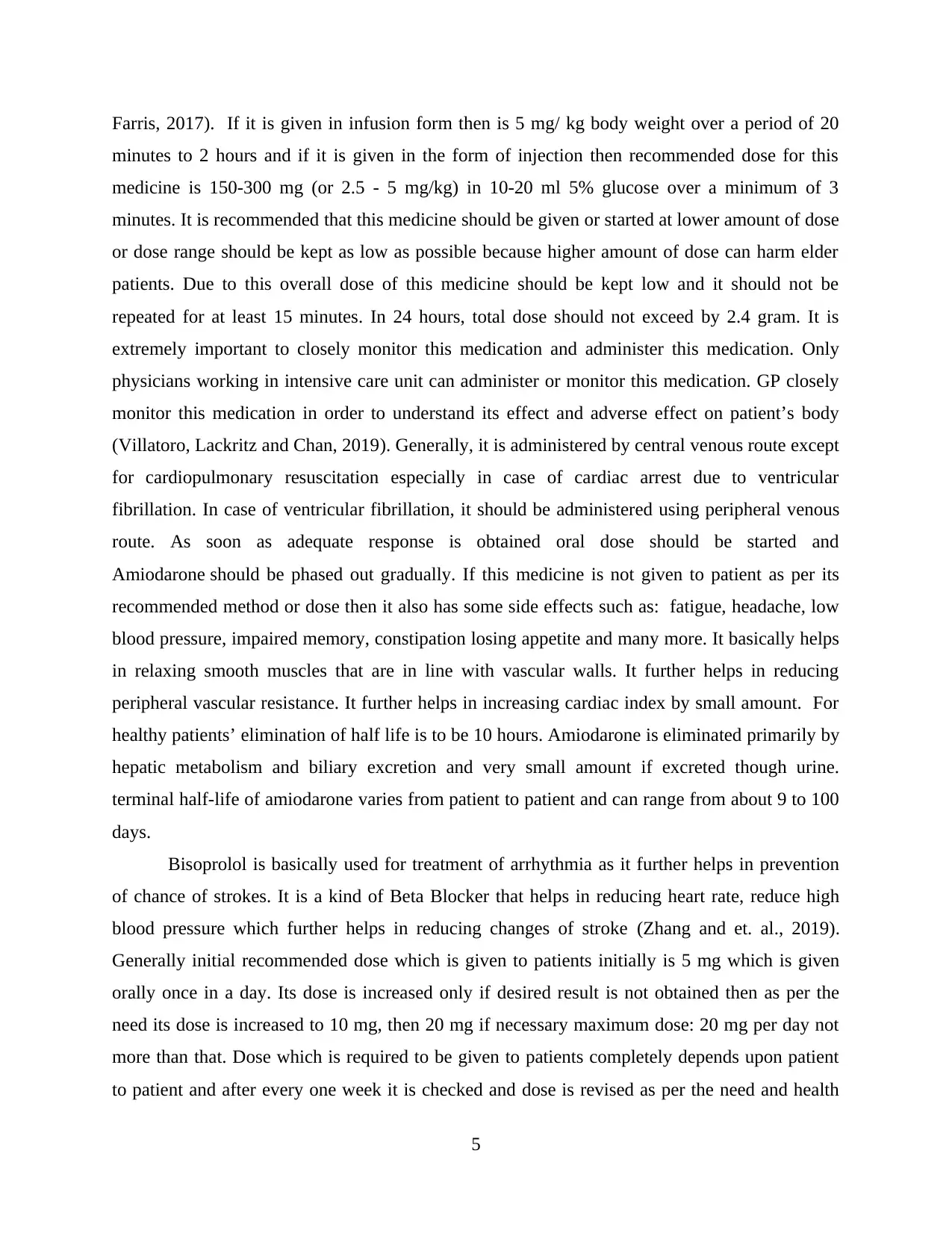
Farris, 2017). If it is given in infusion form then is 5 mg/ kg body weight over a period of 20
minutes to 2 hours and if it is given in the form of injection then recommended dose for this
medicine is 150-300 mg (or 2.5 - 5 mg/kg) in 10-20 ml 5% glucose over a minimum of 3
minutes. It is recommended that this medicine should be given or started at lower amount of dose
or dose range should be kept as low as possible because higher amount of dose can harm elder
patients. Due to this overall dose of this medicine should be kept low and it should not be
repeated for at least 15 minutes. In 24 hours, total dose should not exceed by 2.4 gram. It is
extremely important to closely monitor this medication and administer this medication. Only
physicians working in intensive care unit can administer or monitor this medication. GP closely
monitor this medication in order to understand its effect and adverse effect on patient’s body
(Villatoro, Lackritz and Chan, 2019). Generally, it is administered by central venous route except
for cardiopulmonary resuscitation especially in case of cardiac arrest due to ventricular
fibrillation. In case of ventricular fibrillation, it should be administered using peripheral venous
route. As soon as adequate response is obtained oral dose should be started and
Amiodarone should be phased out gradually. If this medicine is not given to patient as per its
recommended method or dose then it also has some side effects such as: fatigue, headache, low
blood pressure, impaired memory, constipation losing appetite and many more. It basically helps
in relaxing smooth muscles that are in line with vascular walls. It further helps in reducing
peripheral vascular resistance. It further helps in increasing cardiac index by small amount. For
healthy patients’ elimination of half life is to be 10 hours. Amiodarone is eliminated primarily by
hepatic metabolism and biliary excretion and very small amount if excreted though urine.
terminal half-life of amiodarone varies from patient to patient and can range from about 9 to 100
days.
Bisoprolol is basically used for treatment of arrhythmia as it further helps in prevention
of chance of strokes. It is a kind of Beta Blocker that helps in reducing heart rate, reduce high
blood pressure which further helps in reducing changes of stroke (Zhang and et. al., 2019).
Generally initial recommended dose which is given to patients initially is 5 mg which is given
orally once in a day. Its dose is increased only if desired result is not obtained then as per the
need its dose is increased to 10 mg, then 20 mg if necessary maximum dose: 20 mg per day not
more than that. Dose which is required to be given to patients completely depends upon patient
to patient and after every one week it is checked and dose is revised as per the need and health
5
minutes to 2 hours and if it is given in the form of injection then recommended dose for this
medicine is 150-300 mg (or 2.5 - 5 mg/kg) in 10-20 ml 5% glucose over a minimum of 3
minutes. It is recommended that this medicine should be given or started at lower amount of dose
or dose range should be kept as low as possible because higher amount of dose can harm elder
patients. Due to this overall dose of this medicine should be kept low and it should not be
repeated for at least 15 minutes. In 24 hours, total dose should not exceed by 2.4 gram. It is
extremely important to closely monitor this medication and administer this medication. Only
physicians working in intensive care unit can administer or monitor this medication. GP closely
monitor this medication in order to understand its effect and adverse effect on patient’s body
(Villatoro, Lackritz and Chan, 2019). Generally, it is administered by central venous route except
for cardiopulmonary resuscitation especially in case of cardiac arrest due to ventricular
fibrillation. In case of ventricular fibrillation, it should be administered using peripheral venous
route. As soon as adequate response is obtained oral dose should be started and
Amiodarone should be phased out gradually. If this medicine is not given to patient as per its
recommended method or dose then it also has some side effects such as: fatigue, headache, low
blood pressure, impaired memory, constipation losing appetite and many more. It basically helps
in relaxing smooth muscles that are in line with vascular walls. It further helps in reducing
peripheral vascular resistance. It further helps in increasing cardiac index by small amount. For
healthy patients’ elimination of half life is to be 10 hours. Amiodarone is eliminated primarily by
hepatic metabolism and biliary excretion and very small amount if excreted though urine.
terminal half-life of amiodarone varies from patient to patient and can range from about 9 to 100
days.
Bisoprolol is basically used for treatment of arrhythmia as it further helps in prevention
of chance of strokes. It is a kind of Beta Blocker that helps in reducing heart rate, reduce high
blood pressure which further helps in reducing changes of stroke (Zhang and et. al., 2019).
Generally initial recommended dose which is given to patients initially is 5 mg which is given
orally once in a day. Its dose is increased only if desired result is not obtained then as per the
need its dose is increased to 10 mg, then 20 mg if necessary maximum dose: 20 mg per day not
more than that. Dose which is required to be given to patients completely depends upon patient
to patient and after every one week it is checked and dose is revised as per the need and health
5
Paraphrase This Document
Need a fresh take? Get an instant paraphrase of this document with our AI Paraphraser
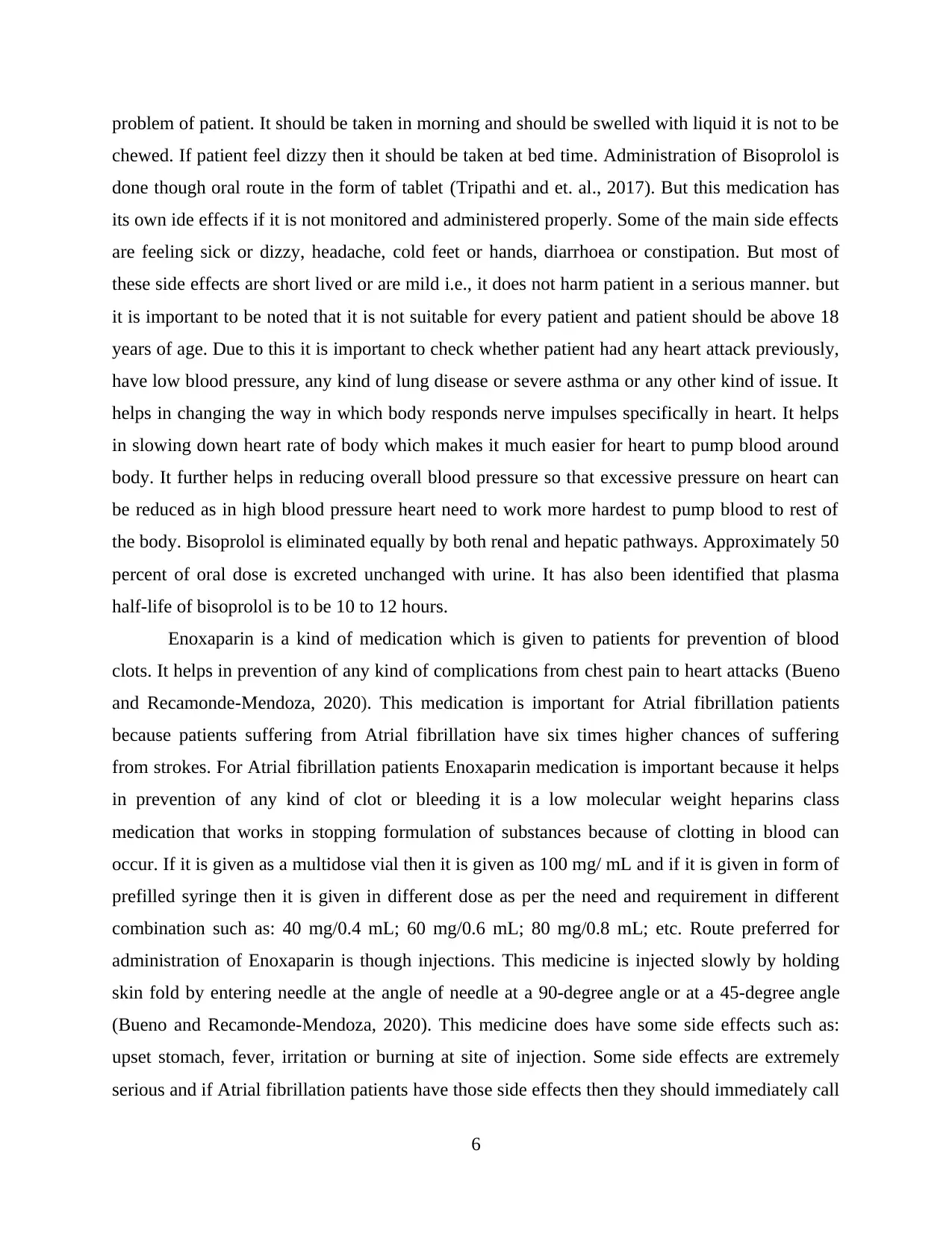
problem of patient. It should be taken in morning and should be swelled with liquid it is not to be
chewed. If patient feel dizzy then it should be taken at bed time. Administration of Bisoprolol is
done though oral route in the form of tablet (Tripathi and et. al., 2017). But this medication has
its own ide effects if it is not monitored and administered properly. Some of the main side effects
are feeling sick or dizzy, headache, cold feet or hands, diarrhoea or constipation. But most of
these side effects are short lived or are mild i.e., it does not harm patient in a serious manner. but
it is important to be noted that it is not suitable for every patient and patient should be above 18
years of age. Due to this it is important to check whether patient had any heart attack previously,
have low blood pressure, any kind of lung disease or severe asthma or any other kind of issue. It
helps in changing the way in which body responds nerve impulses specifically in heart. It helps
in slowing down heart rate of body which makes it much easier for heart to pump blood around
body. It further helps in reducing overall blood pressure so that excessive pressure on heart can
be reduced as in high blood pressure heart need to work more hardest to pump blood to rest of
the body. Bisoprolol is eliminated equally by both renal and hepatic pathways. Approximately 50
percent of oral dose is excreted unchanged with urine. It has also been identified that plasma
half-life of bisoprolol is to be 10 to 12 hours.
Enoxaparin is a kind of medication which is given to patients for prevention of blood
clots. It helps in prevention of any kind of complications from chest pain to heart attacks (Bueno
and Recamonde-Mendoza, 2020). This medication is important for Atrial fibrillation patients
because patients suffering from Atrial fibrillation have six times higher chances of suffering
from strokes. For Atrial fibrillation patients Enoxaparin medication is important because it helps
in prevention of any kind of clot or bleeding it is a low molecular weight heparins class
medication that works in stopping formulation of substances because of clotting in blood can
occur. If it is given as a multidose vial then it is given as 100 mg/ mL and if it is given in form of
prefilled syringe then it is given in different dose as per the need and requirement in different
combination such as: 40 mg/0.4 mL; 60 mg/0.6 mL; 80 mg/0.8 mL; etc. Route preferred for
administration of Enoxaparin is though injections. This medicine is injected slowly by holding
skin fold by entering needle at the angle of needle at a 90-degree angle or at a 45-degree angle
(Bueno and Recamonde-Mendoza, 2020). This medicine does have some side effects such as:
upset stomach, fever, irritation or burning at site of injection. Some side effects are extremely
serious and if Atrial fibrillation patients have those side effects then they should immediately call
6
chewed. If patient feel dizzy then it should be taken at bed time. Administration of Bisoprolol is
done though oral route in the form of tablet (Tripathi and et. al., 2017). But this medication has
its own ide effects if it is not monitored and administered properly. Some of the main side effects
are feeling sick or dizzy, headache, cold feet or hands, diarrhoea or constipation. But most of
these side effects are short lived or are mild i.e., it does not harm patient in a serious manner. but
it is important to be noted that it is not suitable for every patient and patient should be above 18
years of age. Due to this it is important to check whether patient had any heart attack previously,
have low blood pressure, any kind of lung disease or severe asthma or any other kind of issue. It
helps in changing the way in which body responds nerve impulses specifically in heart. It helps
in slowing down heart rate of body which makes it much easier for heart to pump blood around
body. It further helps in reducing overall blood pressure so that excessive pressure on heart can
be reduced as in high blood pressure heart need to work more hardest to pump blood to rest of
the body. Bisoprolol is eliminated equally by both renal and hepatic pathways. Approximately 50
percent of oral dose is excreted unchanged with urine. It has also been identified that plasma
half-life of bisoprolol is to be 10 to 12 hours.
Enoxaparin is a kind of medication which is given to patients for prevention of blood
clots. It helps in prevention of any kind of complications from chest pain to heart attacks (Bueno
and Recamonde-Mendoza, 2020). This medication is important for Atrial fibrillation patients
because patients suffering from Atrial fibrillation have six times higher chances of suffering
from strokes. For Atrial fibrillation patients Enoxaparin medication is important because it helps
in prevention of any kind of clot or bleeding it is a low molecular weight heparins class
medication that works in stopping formulation of substances because of clotting in blood can
occur. If it is given as a multidose vial then it is given as 100 mg/ mL and if it is given in form of
prefilled syringe then it is given in different dose as per the need and requirement in different
combination such as: 40 mg/0.4 mL; 60 mg/0.6 mL; 80 mg/0.8 mL; etc. Route preferred for
administration of Enoxaparin is though injections. This medicine is injected slowly by holding
skin fold by entering needle at the angle of needle at a 90-degree angle or at a 45-degree angle
(Bueno and Recamonde-Mendoza, 2020). This medicine does have some side effects such as:
upset stomach, fever, irritation or burning at site of injection. Some side effects are extremely
serious and if Atrial fibrillation patients have those side effects then they should immediately call
6
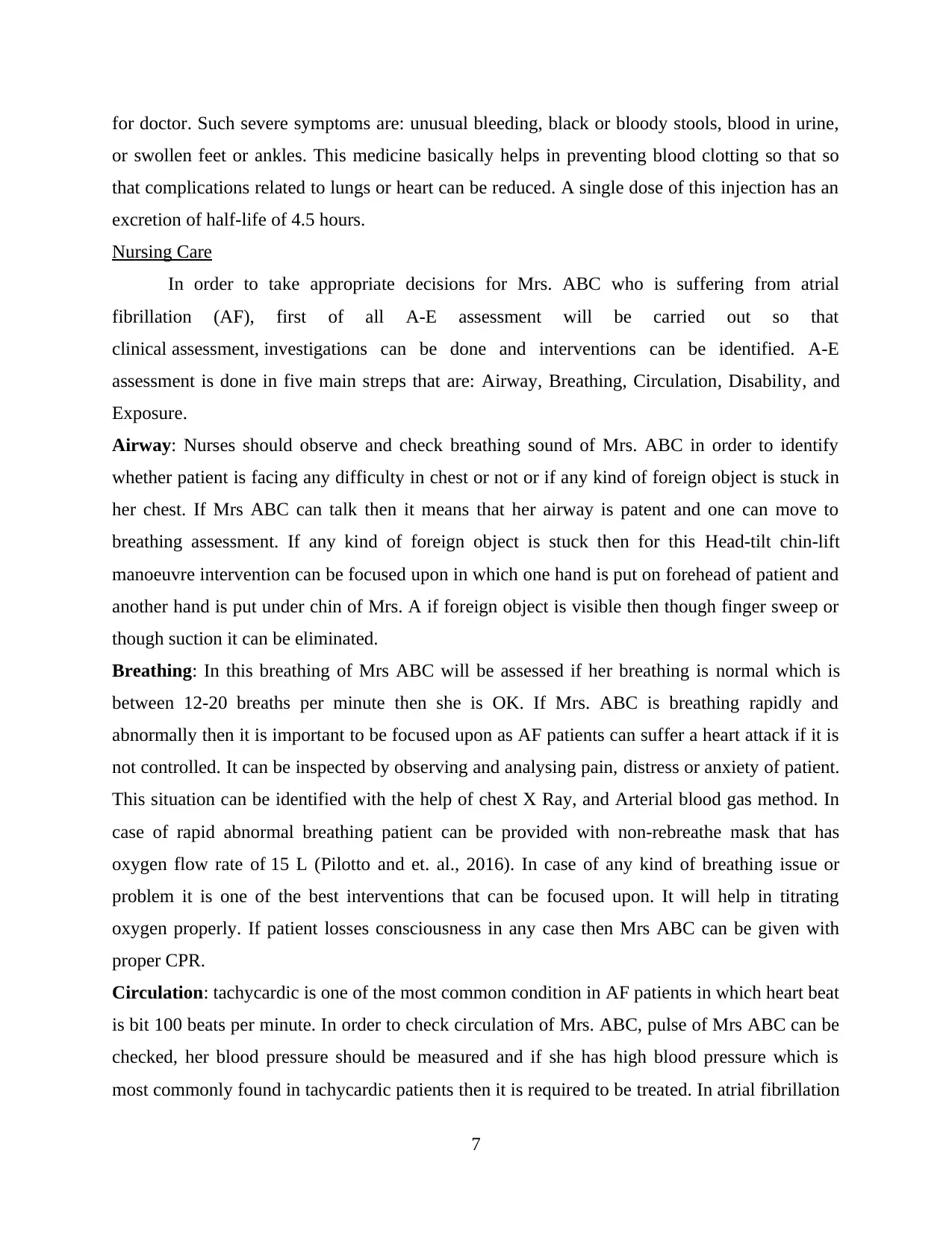
for doctor. Such severe symptoms are: unusual bleeding, black or bloody stools, blood in urine,
or swollen feet or ankles. This medicine basically helps in preventing blood clotting so that so
that complications related to lungs or heart can be reduced. A single dose of this injection has an
excretion of half-life of 4.5 hours.
Nursing Care
In order to take appropriate decisions for Mrs. ABC who is suffering from atrial
fibrillation (AF), first of all A-E assessment will be carried out so that
clinical assessment, investigations can be done and interventions can be identified. A-E
assessment is done in five main streps that are: Airway, Breathing, Circulation, Disability, and
Exposure.
Airway: Nurses should observe and check breathing sound of Mrs. ABC in order to identify
whether patient is facing any difficulty in chest or not or if any kind of foreign object is stuck in
her chest. If Mrs ABC can talk then it means that her airway is patent and one can move to
breathing assessment. If any kind of foreign object is stuck then for this Head-tilt chin-lift
manoeuvre intervention can be focused upon in which one hand is put on forehead of patient and
another hand is put under chin of Mrs. A if foreign object is visible then though finger sweep or
though suction it can be eliminated.
Breathing: In this breathing of Mrs ABC will be assessed if her breathing is normal which is
between 12-20 breaths per minute then she is OK. If Mrs. ABC is breathing rapidly and
abnormally then it is important to be focused upon as AF patients can suffer a heart attack if it is
not controlled. It can be inspected by observing and analysing pain, distress or anxiety of patient.
This situation can be identified with the help of chest X Ray, and Arterial blood gas method. In
case of rapid abnormal breathing patient can be provided with non-rebreathe mask that has
oxygen flow rate of 15 L (Pilotto and et. al., 2016). In case of any kind of breathing issue or
problem it is one of the best interventions that can be focused upon. It will help in titrating
oxygen properly. If patient losses consciousness in any case then Mrs ABC can be given with
proper CPR.
Circulation: tachycardic is one of the most common condition in AF patients in which heart beat
is bit 100 beats per minute. In order to check circulation of Mrs. ABC, pulse of Mrs ABC can be
checked, her blood pressure should be measured and if she has high blood pressure which is
most commonly found in tachycardic patients then it is required to be treated. In atrial fibrillation
7
or swollen feet or ankles. This medicine basically helps in preventing blood clotting so that so
that complications related to lungs or heart can be reduced. A single dose of this injection has an
excretion of half-life of 4.5 hours.
Nursing Care
In order to take appropriate decisions for Mrs. ABC who is suffering from atrial
fibrillation (AF), first of all A-E assessment will be carried out so that
clinical assessment, investigations can be done and interventions can be identified. A-E
assessment is done in five main streps that are: Airway, Breathing, Circulation, Disability, and
Exposure.
Airway: Nurses should observe and check breathing sound of Mrs. ABC in order to identify
whether patient is facing any difficulty in chest or not or if any kind of foreign object is stuck in
her chest. If Mrs ABC can talk then it means that her airway is patent and one can move to
breathing assessment. If any kind of foreign object is stuck then for this Head-tilt chin-lift
manoeuvre intervention can be focused upon in which one hand is put on forehead of patient and
another hand is put under chin of Mrs. A if foreign object is visible then though finger sweep or
though suction it can be eliminated.
Breathing: In this breathing of Mrs ABC will be assessed if her breathing is normal which is
between 12-20 breaths per minute then she is OK. If Mrs. ABC is breathing rapidly and
abnormally then it is important to be focused upon as AF patients can suffer a heart attack if it is
not controlled. It can be inspected by observing and analysing pain, distress or anxiety of patient.
This situation can be identified with the help of chest X Ray, and Arterial blood gas method. In
case of rapid abnormal breathing patient can be provided with non-rebreathe mask that has
oxygen flow rate of 15 L (Pilotto and et. al., 2016). In case of any kind of breathing issue or
problem it is one of the best interventions that can be focused upon. It will help in titrating
oxygen properly. If patient losses consciousness in any case then Mrs ABC can be given with
proper CPR.
Circulation: tachycardic is one of the most common condition in AF patients in which heart beat
is bit 100 beats per minute. In order to check circulation of Mrs. ABC, pulse of Mrs ABC can be
checked, her blood pressure should be measured and if she has high blood pressure which is
most commonly found in tachycardic patients then it is required to be treated. In atrial fibrillation
7
⊘ This is a preview!⊘
Do you want full access?
Subscribe today to unlock all pages.

Trusted by 1+ million students worldwide
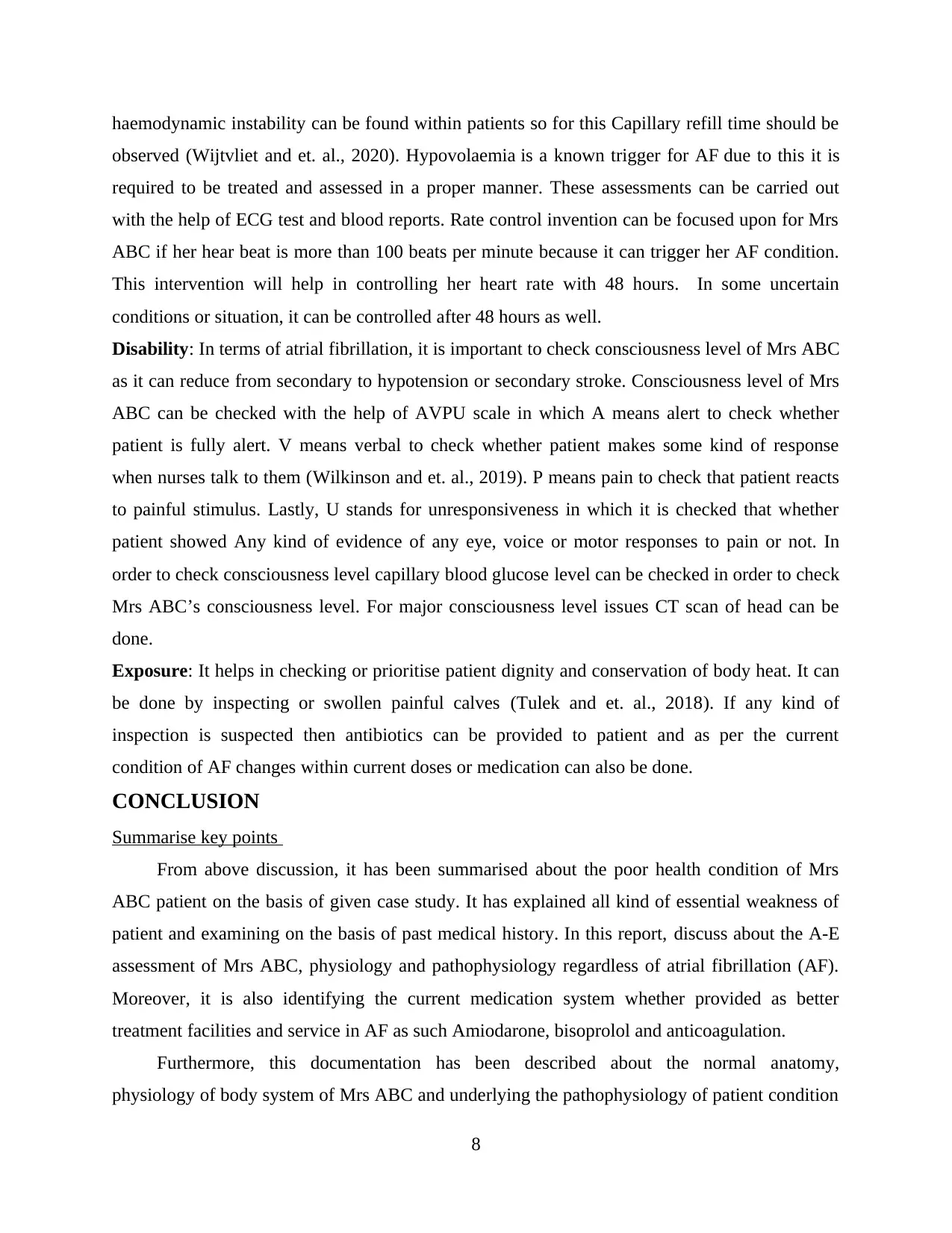
haemodynamic instability can be found within patients so for this Capillary refill time should be
observed (Wijtvliet and et. al., 2020). Hypovolaemia is a known trigger for AF due to this it is
required to be treated and assessed in a proper manner. These assessments can be carried out
with the help of ECG test and blood reports. Rate control invention can be focused upon for Mrs
ABC if her hear beat is more than 100 beats per minute because it can trigger her AF condition.
This intervention will help in controlling her heart rate with 48 hours. In some uncertain
conditions or situation, it can be controlled after 48 hours as well.
Disability: In terms of atrial fibrillation, it is important to check consciousness level of Mrs ABC
as it can reduce from secondary to hypotension or secondary stroke. Consciousness level of Mrs
ABC can be checked with the help of AVPU scale in which A means alert to check whether
patient is fully alert. V means verbal to check whether patient makes some kind of response
when nurses talk to them (Wilkinson and et. al., 2019). P means pain to check that patient reacts
to painful stimulus. Lastly, U stands for unresponsiveness in which it is checked that whether
patient showed Any kind of evidence of any eye, voice or motor responses to pain or not. In
order to check consciousness level capillary blood glucose level can be checked in order to check
Mrs ABC’s consciousness level. For major consciousness level issues CT scan of head can be
done.
Exposure: It helps in checking or prioritise patient dignity and conservation of body heat. It can
be done by inspecting or swollen painful calves (Tulek and et. al., 2018). If any kind of
inspection is suspected then antibiotics can be provided to patient and as per the current
condition of AF changes within current doses or medication can also be done.
CONCLUSION
Summarise key points
From above discussion, it has been summarised about the poor health condition of Mrs
ABC patient on the basis of given case study. It has explained all kind of essential weakness of
patient and examining on the basis of past medical history. In this report, discuss about the A-E
assessment of Mrs ABC, physiology and pathophysiology regardless of atrial fibrillation (AF).
Moreover, it is also identifying the current medication system whether provided as better
treatment facilities and service in AF as such Amiodarone, bisoprolol and anticoagulation.
Furthermore, this documentation has been described about the normal anatomy,
physiology of body system of Mrs ABC and underlying the pathophysiology of patient condition
8
observed (Wijtvliet and et. al., 2020). Hypovolaemia is a known trigger for AF due to this it is
required to be treated and assessed in a proper manner. These assessments can be carried out
with the help of ECG test and blood reports. Rate control invention can be focused upon for Mrs
ABC if her hear beat is more than 100 beats per minute because it can trigger her AF condition.
This intervention will help in controlling her heart rate with 48 hours. In some uncertain
conditions or situation, it can be controlled after 48 hours as well.
Disability: In terms of atrial fibrillation, it is important to check consciousness level of Mrs ABC
as it can reduce from secondary to hypotension or secondary stroke. Consciousness level of Mrs
ABC can be checked with the help of AVPU scale in which A means alert to check whether
patient is fully alert. V means verbal to check whether patient makes some kind of response
when nurses talk to them (Wilkinson and et. al., 2019). P means pain to check that patient reacts
to painful stimulus. Lastly, U stands for unresponsiveness in which it is checked that whether
patient showed Any kind of evidence of any eye, voice or motor responses to pain or not. In
order to check consciousness level capillary blood glucose level can be checked in order to check
Mrs ABC’s consciousness level. For major consciousness level issues CT scan of head can be
done.
Exposure: It helps in checking or prioritise patient dignity and conservation of body heat. It can
be done by inspecting or swollen painful calves (Tulek and et. al., 2018). If any kind of
inspection is suspected then antibiotics can be provided to patient and as per the current
condition of AF changes within current doses or medication can also be done.
CONCLUSION
Summarise key points
From above discussion, it has been summarised about the poor health condition of Mrs
ABC patient on the basis of given case study. It has explained all kind of essential weakness of
patient and examining on the basis of past medical history. In this report, discuss about the A-E
assessment of Mrs ABC, physiology and pathophysiology regardless of atrial fibrillation (AF).
Moreover, it is also identifying the current medication system whether provided as better
treatment facilities and service in AF as such Amiodarone, bisoprolol and anticoagulation.
Furthermore, this documentation has been described about the normal anatomy,
physiology of body system of Mrs ABC and underlying the pathophysiology of patient condition
8
Paraphrase This Document
Need a fresh take? Get an instant paraphrase of this document with our AI Paraphraser
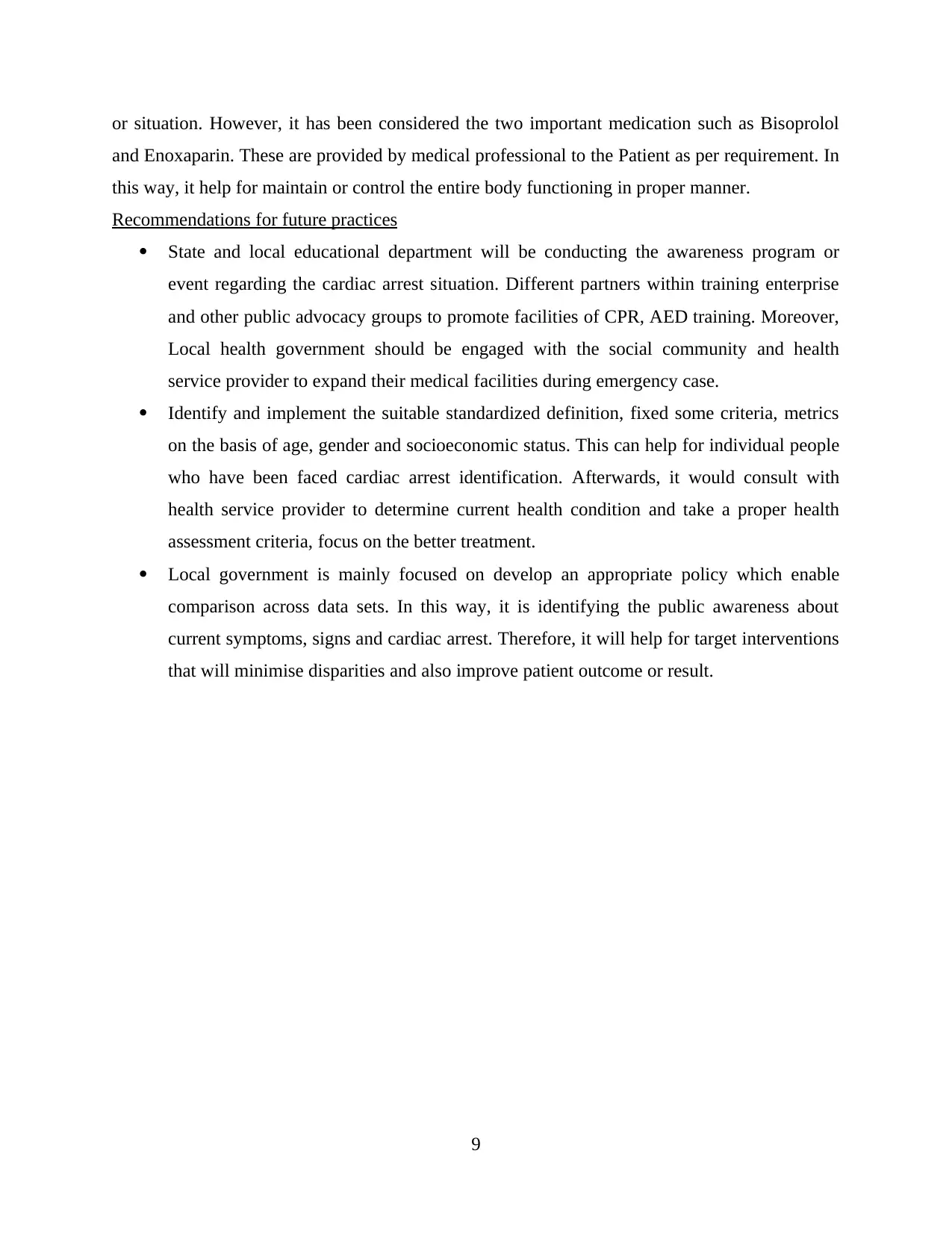
or situation. However, it has been considered the two important medication such as Bisoprolol
and Enoxaparin. These are provided by medical professional to the Patient as per requirement. In
this way, it help for maintain or control the entire body functioning in proper manner.
Recommendations for future practices
State and local educational department will be conducting the awareness program or
event regarding the cardiac arrest situation. Different partners within training enterprise
and other public advocacy groups to promote facilities of CPR, AED training. Moreover,
Local health government should be engaged with the social community and health
service provider to expand their medical facilities during emergency case.
Identify and implement the suitable standardized definition, fixed some criteria, metrics
on the basis of age, gender and socioeconomic status. This can help for individual people
who have been faced cardiac arrest identification. Afterwards, it would consult with
health service provider to determine current health condition and take a proper health
assessment criteria, focus on the better treatment.
Local government is mainly focused on develop an appropriate policy which enable
comparison across data sets. In this way, it is identifying the public awareness about
current symptoms, signs and cardiac arrest. Therefore, it will help for target interventions
that will minimise disparities and also improve patient outcome or result.
9
and Enoxaparin. These are provided by medical professional to the Patient as per requirement. In
this way, it help for maintain or control the entire body functioning in proper manner.
Recommendations for future practices
State and local educational department will be conducting the awareness program or
event regarding the cardiac arrest situation. Different partners within training enterprise
and other public advocacy groups to promote facilities of CPR, AED training. Moreover,
Local health government should be engaged with the social community and health
service provider to expand their medical facilities during emergency case.
Identify and implement the suitable standardized definition, fixed some criteria, metrics
on the basis of age, gender and socioeconomic status. This can help for individual people
who have been faced cardiac arrest identification. Afterwards, it would consult with
health service provider to determine current health condition and take a proper health
assessment criteria, focus on the better treatment.
Local government is mainly focused on develop an appropriate policy which enable
comparison across data sets. In this way, it is identifying the public awareness about
current symptoms, signs and cardiac arrest. Therefore, it will help for target interventions
that will minimise disparities and also improve patient outcome or result.
9
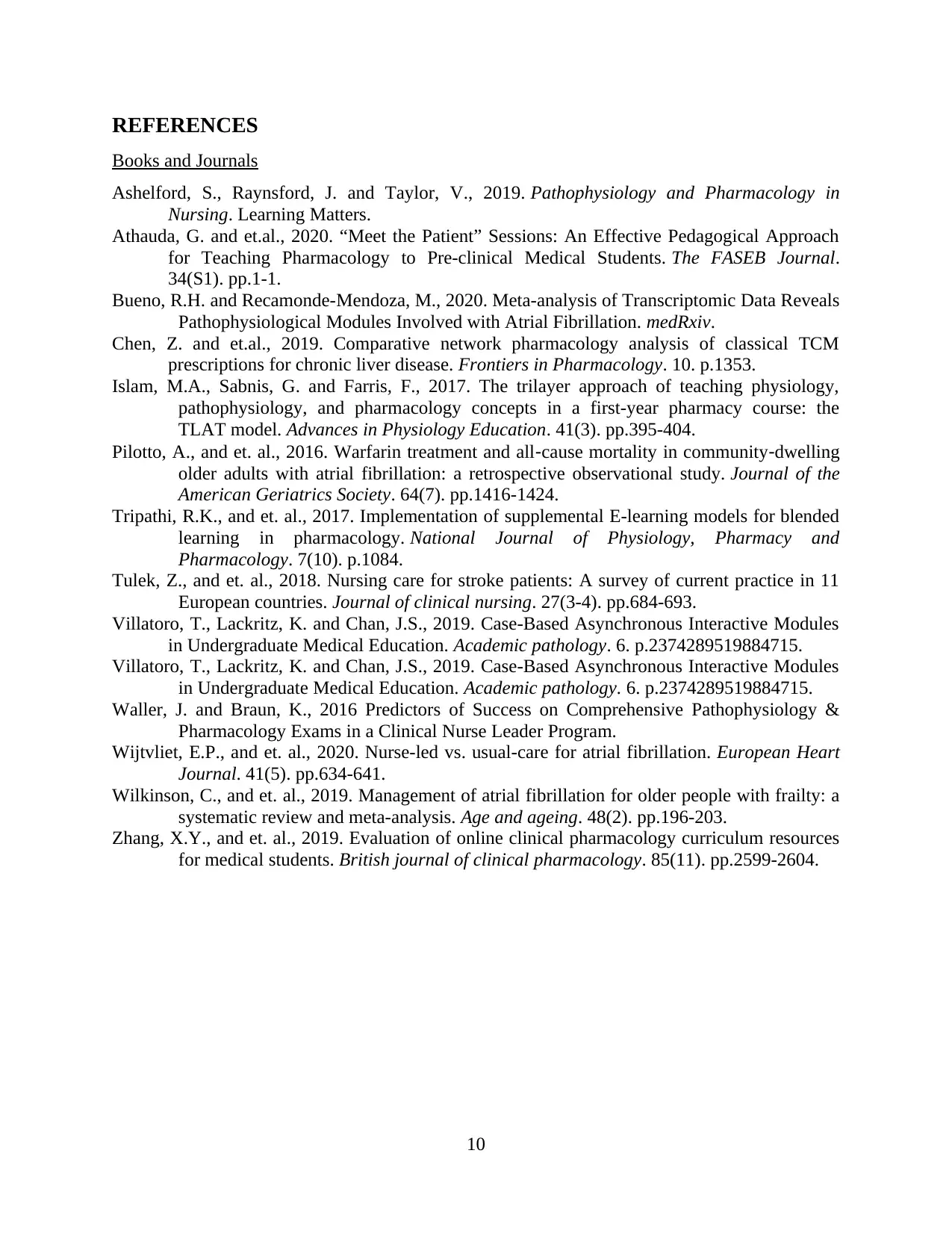
REFERENCES
Books and Journals
Ashelford, S., Raynsford, J. and Taylor, V., 2019. Pathophysiology and Pharmacology in
Nursing. Learning Matters.
Athauda, G. and et.al., 2020. “Meet the Patient” Sessions: An Effective Pedagogical Approach
for Teaching Pharmacology to Pre‐clinical Medical Students. The FASEB Journal.
34(S1). pp.1-1.
Bueno, R.H. and Recamonde-Mendoza, M., 2020. Meta-analysis of Transcriptomic Data Reveals
Pathophysiological Modules Involved with Atrial Fibrillation. medRxiv.
Chen, Z. and et.al., 2019. Comparative network pharmacology analysis of classical TCM
prescriptions for chronic liver disease. Frontiers in Pharmacology. 10. p.1353.
Islam, M.A., Sabnis, G. and Farris, F., 2017. The trilayer approach of teaching physiology,
pathophysiology, and pharmacology concepts in a first-year pharmacy course: the
TLAT model. Advances in Physiology Education. 41(3). pp.395-404.
Pilotto, A., and et. al., 2016. Warfarin treatment and all‐cause mortality in community‐dwelling
older adults with atrial fibrillation: a retrospective observational study. Journal of the
American Geriatrics Society. 64(7). pp.1416-1424.
Tripathi, R.K., and et. al., 2017. Implementation of supplemental E-learning models for blended
learning in pharmacology. National Journal of Physiology, Pharmacy and
Pharmacology. 7(10). p.1084.
Tulek, Z., and et. al., 2018. Nursing care for stroke patients: A survey of current practice in 11
European countries. Journal of clinical nursing. 27(3-4). pp.684-693.
Villatoro, T., Lackritz, K. and Chan, J.S., 2019. Case-Based Asynchronous Interactive Modules
in Undergraduate Medical Education. Academic pathology. 6. p.2374289519884715.
Villatoro, T., Lackritz, K. and Chan, J.S., 2019. Case-Based Asynchronous Interactive Modules
in Undergraduate Medical Education. Academic pathology. 6. p.2374289519884715.
Waller, J. and Braun, K., 2016 Predictors of Success on Comprehensive Pathophysiology &
Pharmacology Exams in a Clinical Nurse Leader Program.
Wijtvliet, E.P., and et. al., 2020. Nurse-led vs. usual-care for atrial fibrillation. European Heart
Journal. 41(5). pp.634-641.
Wilkinson, C., and et. al., 2019. Management of atrial fibrillation for older people with frailty: a
systematic review and meta-analysis. Age and ageing. 48(2). pp.196-203.
Zhang, X.Y., and et. al., 2019. Evaluation of online clinical pharmacology curriculum resources
for medical students. British journal of clinical pharmacology. 85(11). pp.2599-2604.
10
Books and Journals
Ashelford, S., Raynsford, J. and Taylor, V., 2019. Pathophysiology and Pharmacology in
Nursing. Learning Matters.
Athauda, G. and et.al., 2020. “Meet the Patient” Sessions: An Effective Pedagogical Approach
for Teaching Pharmacology to Pre‐clinical Medical Students. The FASEB Journal.
34(S1). pp.1-1.
Bueno, R.H. and Recamonde-Mendoza, M., 2020. Meta-analysis of Transcriptomic Data Reveals
Pathophysiological Modules Involved with Atrial Fibrillation. medRxiv.
Chen, Z. and et.al., 2019. Comparative network pharmacology analysis of classical TCM
prescriptions for chronic liver disease. Frontiers in Pharmacology. 10. p.1353.
Islam, M.A., Sabnis, G. and Farris, F., 2017. The trilayer approach of teaching physiology,
pathophysiology, and pharmacology concepts in a first-year pharmacy course: the
TLAT model. Advances in Physiology Education. 41(3). pp.395-404.
Pilotto, A., and et. al., 2016. Warfarin treatment and all‐cause mortality in community‐dwelling
older adults with atrial fibrillation: a retrospective observational study. Journal of the
American Geriatrics Society. 64(7). pp.1416-1424.
Tripathi, R.K., and et. al., 2017. Implementation of supplemental E-learning models for blended
learning in pharmacology. National Journal of Physiology, Pharmacy and
Pharmacology. 7(10). p.1084.
Tulek, Z., and et. al., 2018. Nursing care for stroke patients: A survey of current practice in 11
European countries. Journal of clinical nursing. 27(3-4). pp.684-693.
Villatoro, T., Lackritz, K. and Chan, J.S., 2019. Case-Based Asynchronous Interactive Modules
in Undergraduate Medical Education. Academic pathology. 6. p.2374289519884715.
Villatoro, T., Lackritz, K. and Chan, J.S., 2019. Case-Based Asynchronous Interactive Modules
in Undergraduate Medical Education. Academic pathology. 6. p.2374289519884715.
Waller, J. and Braun, K., 2016 Predictors of Success on Comprehensive Pathophysiology &
Pharmacology Exams in a Clinical Nurse Leader Program.
Wijtvliet, E.P., and et. al., 2020. Nurse-led vs. usual-care for atrial fibrillation. European Heart
Journal. 41(5). pp.634-641.
Wilkinson, C., and et. al., 2019. Management of atrial fibrillation for older people with frailty: a
systematic review and meta-analysis. Age and ageing. 48(2). pp.196-203.
Zhang, X.Y., and et. al., 2019. Evaluation of online clinical pharmacology curriculum resources
for medical students. British journal of clinical pharmacology. 85(11). pp.2599-2604.
10
⊘ This is a preview!⊘
Do you want full access?
Subscribe today to unlock all pages.

Trusted by 1+ million students worldwide
1 out of 12
Related Documents
Your All-in-One AI-Powered Toolkit for Academic Success.
+13062052269
info@desklib.com
Available 24*7 on WhatsApp / Email
![[object Object]](/_next/static/media/star-bottom.7253800d.svg)
Unlock your academic potential
Copyright © 2020–2026 A2Z Services. All Rights Reserved. Developed and managed by ZUCOL.





